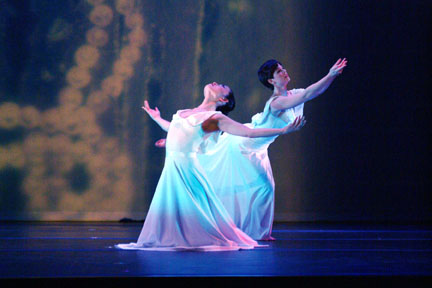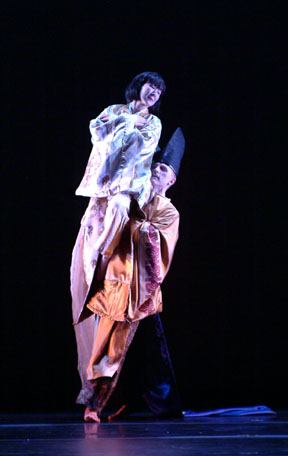An American Genji
Saeko
Ichinohe Dance Company
35th Anniversary Celebration
The Kaye Playhouse at Hunter College, New York
March 31, 2005
by
Tom Phillips
copyright
©2005 by Tom Phillips
 Back
in 1970, sushi bars were just appearing in New York, and places like Japan
House and the Zen Studies Society were isolated outposts of what was still
an extremely foreign culture. That was when Saeko Ichinohe, a Japanese
graduate of the Juilliard School, started her dance company with the aim
of combining western and Japanese dance traditions. Today, there’s
sushi in every supermarket, and Americans have become not just consumers
but producers of Japanese culture. That was the message at the 35th anniversary
celebration of the Saeko Ichinohe Dance Company at Hunter College, and
it was personified by an all-American young man who can dance and choreograph
in the traditional Japanese style, and even move around in the house-like
costumes of traditional Japanese theater. Jeff Moen has been a disciple
of Ichinohe for ten years, and now he appears in line to be her heir.
Back
in 1970, sushi bars were just appearing in New York, and places like Japan
House and the Zen Studies Society were isolated outposts of what was still
an extremely foreign culture. That was when Saeko Ichinohe, a Japanese
graduate of the Juilliard School, started her dance company with the aim
of combining western and Japanese dance traditions. Today, there’s
sushi in every supermarket, and Americans have become not just consumers
but producers of Japanese culture. That was the message at the 35th anniversary
celebration of the Saeko Ichinohe Dance Company at Hunter College, and
it was personified by an all-American young man who can dance and choreograph
in the traditional Japanese style, and even move around in the house-like
costumes of traditional Japanese theater. Jeff Moen has been a disciple
of Ichinohe for ten years, and now he appears in line to be her heir.
American audiences, he says, are shocked when they first see him, a fresh-faced midwesterner, decked out in the silken robes and soaring headgear of the medieval Prince Genji. (Japanese audiences are OK with it, he says.) But in any case, the problem quickly disappears when you see his command of the stylized gestures from Kabuki and Noh Theater. Ichinohe’s choreography for “The Tale of Genji” combines Japanese ritualism with erotic partnering from ballet and modern dance, worked together in a seamless fashion. Moen and Yukie Okuyama put on a passionate pas de deux, freed of courtly uptightness but still following the basic Kabuki rule: it’s the costume that’s moving, the dancer is just working it from inside.
 Unencumbered
by imperial attire was Moen’s own premiere, “Dreams Wandering
Over a Withered Field,” based on haiku poems by Basho. The audience
never hears the poems, just a spare score for flute and percussion, but
somehow we pick up the mood of melancholy intensity, of letting go. Mostly
this is because of a masterful performance by Yukie Okuyama, a woman playing
the poet himself. The role is abstract: she enters carrying a wooden rod,
points and stretches with it, yearns through it, then finally lays it
down, bequeathing it to a chorus of three young women dancers. Then in
a climactic gesture, she reaches to the heavens, opens her mouth and seems
to take in the universe, to “swallow the stars to the bottom of
her belly.” Basho’s cryptic expansiveness is hard to match
in movement, but Moen’s choreography comes close.
Unencumbered
by imperial attire was Moen’s own premiere, “Dreams Wandering
Over a Withered Field,” based on haiku poems by Basho. The audience
never hears the poems, just a spare score for flute and percussion, but
somehow we pick up the mood of melancholy intensity, of letting go. Mostly
this is because of a masterful performance by Yukie Okuyama, a woman playing
the poet himself. The role is abstract: she enters carrying a wooden rod,
points and stretches with it, yearns through it, then finally lays it
down, bequeathing it to a chorus of three young women dancers. Then in
a climactic gesture, she reaches to the heavens, opens her mouth and seems
to take in the universe, to “swallow the stars to the bottom of
her belly.” Basho’s cryptic expansiveness is hard to match
in movement, but Moen’s choreography comes close.
Most of the program was a retrospective of Ichinohe’s choreography going back to the 60’s. The most exhilarating piece was “Variation for Taiko,” from 1981, with a score of Japanese folk drumming, followed by a long stretch of silence. In that space, two women and a man leaped and bounced, kicked and stomped, flexing feet and clenching fists. The movements emphasized the breadth and power of the body, often facing front in a wide knee-bend—the platform for the explosive thrusts of Asian martial arts.
The weirdest and funniest piece was called “Head,” from 1984, with a jumping John Cage score that sounded like a pinball machine from space. It began with a solo for a red-clad rag doll, Shiho Miyazawa, who clutched her buns and wagged her head as if propelled around the stage by a random puppeteer; then a trio of women with hooded heads and long finger ornaments, facing rear and wiggling their hands where their heads would normally appear. It brought back an era of art—Alwin Nikolais, the rock group Devo—that explored the reduction of humanity to brainless automatons. There was always something ironic and defiant about that pose, and here it was done with wit and delight.
Most of Ichinohe’s dancers are veterans of the Merce Cunningham Studio, and their cool control showed the influence of American’s most Zen choreographer. But standing out from the bunch was a young lady with a lifetime of ballet in her every move. Haruno Yoshida gave us lines so clean and lifts so light that we hardly needed to look at the program to know that she has been “involved in ballet since the age of five.”
Photographs copyright Nan Melville and used with her kind permission.
Volume 3,
No. 14
April 11, 2005
copyright
©2005
Tom Philliips
www.danceviewtimes.com
|
|
|